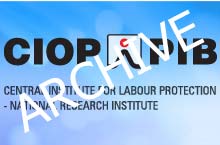|
|
INTERNATIONAL JOURNAL OF OCCUPATIONAL SAFETY AND ERGONOMICS
Volume 14 Number 1, 2008
|
CONTENTS:
Articles:
- Thermal Strain in Fire Fighters While Wearing Task-Fitted Versus EN 469:2005 Protective Clothing During a Prolonged Rescue Drill
Raija Ilmarinen, Helena Mäkinen, Harri Lindholm, Anne Punakallio & Heikki Kervinen, 7-18 
- Development of a Test Method Against Hot Alkaline Chemical Splashes
Helena Mäkinen, Kalevi Nieminen, Susanna Mäki & Sirkku Siiskonen, 19-28 
- Protection From Steam at High Pressures: Development of a Test Device and Protocol
Rohit Sati, Elizabeth M. Crown, Mark Ackerman, Jose Gonzalez & Douglas Dale, 29-41 
- Optimizing the Performance of Phase-Change Materials in Personal Protective Clothing Systems
Randi Eidsmo Reinertsen, Hilde F?revik, Kristine Holb?, Ragnhild Nesbakken, Jarl Reitan, Arne R?yset & Maria Suong Le Thi, 43-53 
- Performance of Firefighters’ Protective Clothing After Heat Exposure
René M. Rossi, Walter Bolli & Rolf Stämpfli, 55-60 
- Evaluation of the Flexibility of Protective Gloves
Lotfi Harrabi, Patricia I. Dolez, Toan Vu-Khanh & Jaime Lara, 61-68 
- Dry and Wet Heat Transfer Through Clothing Dependent on the Clothing Properties Under Cold Conditions
Mark G.M. Richards, René Rossi, Harriet Meinander, Peter Broede, Victor Candas, Emiel den Hartog, Ingvar Holmér, Wolfgang Nocker & George Havenith, 69-76 
- Variable-Thermoinsulation Garments With a Microprocessor Temperature Controller
Agnieszka Kurczewska & Jacek Leśnikowski, 77-87 
- Numerical Simulations of Heat and Moisture Transport in Thermal Protective Clothing Under Flash Fire Conditions
Guowen Song, Patirop Chitrphiromsri & Dan Ding, 89-106 
|
  Review Review
 |
Thermal Strain in Fire Fighters While Wearing Task-Fitted Versus EN 469:2005 Protective Clothing During a Prolonged Rescue Drill
Raija Ilmarinen, Helena Mäkinen, Harri Lindholm, Anne Punakallio & Heikki Kervinen
Fire fighters are normally overprotected during their working hours because of the tendency to keep the personal protection level sufficiently high in case of the worst possible scenarios. This study investigated the effects of task-fitted protective clothing on thermal strain in fire fighters as compared to EN 469:2005 protective clothing during a prolonged (2 1/2 hrs) job-related rescue drill under neutral and hot climates. The subjects were 23 healthy, physically fit professional male fire fighters aged 26–44 years. Measurements included cardiovascular and thermal responses and subjective assessments. Wearing task-fitted clothing during rescue tasks in a neutral climate considerably reduced total thermal and cardiovascular strain in prolonged rescue work. The fire fighters also perceived physical work as significantly harder on average, and reported more intense subjective discomfort while wearing EN 469:2005 as compared to task-fitted clothing.
 |
Development of a Test Method Against Hot Alkaline Chemical Splashes
Raija Ilmarinen, Helena Mäkinen, Harri Lindholm, Anne Punakallio & Heikki Kervinen
High temperature alkaline chemical liquids have caused injuries and hazardous situations in Finnish pulp manufacturing mills. There are no requirements and/or test method standards concerning protection against high temperature alkaline chemical splashes. This paper describes the test method development process to test and identify materials appropriate for hot liquid chemical hazard protection. In the first phase, the liquid was spilled through a stainless steel funnel and the protection performance was evaluated using a polyvinyl chloride (PVC) film under the test material. After several tentative improvements, a graphite crucible was used for heating and spilling the chemical, and a copper-coated K-type thermometer with 4 independent measuring areas was designed to measure the temperature under the material samples. The thermometer was designed to respond quickly so that peak temperatures could be measured. The main problem was to keep the spilled amount of chemical constant, which unfortunately resulted in significant variability in data.
 |
Protection From Steam at High Pressures: Development of a Test Device and Protocol
Rohit Sati, Elizabeth M. Crown, Mark Ackerman, Jose Gonzalez & Douglas Dale
Extensive use of pressurized steam in the oil and gas sectors has led to incidents where workers were seriously injured. In this study a test device and procedure to measure heat transfer through fabrics during steam exposure were developed and evaluated. Several factors were considered while designing the test device to simulate work site conditions. Fabrics were exposed to steam at 2 distances (50 and 100 mm) and 2 pressures (207 and 69 kPa). Theoretical considerations included heat and mass transfer, and fabric structure and performance properties. The test device and procedure differentiated well among both fabrics and exposure conditions. For all fabrics, maximum heat transfer was observed at highest steam pressure and shortest distance. Laminated and coated fabrics performed better than a fabric without such treatments.
 |
Optimizing the Performance of Phase-Change Materials in Personal Protective Clothing Systems
Randi Eidsmo Reinertsen, Hilde Fǽrevik, Kristine Holbǿ, Ragnhild Nesbakken, Jarl Reitan, Arne Rǿyset & Maria Suong Le Thi
Phase-change materials (PCM) can be used to reduce thermal stress and improve thermal comfort for workers wearing protective clothing. The aim of this study was to investigate the effect of PCM in protective clothing used in simulated work situations. We hypothesized that it would be possible to optimize cooling performance with a design that focuses on careful positioning of PCM, minimizing total insulation and facilitating moisture transport. Thermal stress and thermal comfort were estimated through measurement of body heat production, body temperatures, sweat production, relative humidity in clothing and subjective ratings of thermal comfort, thermal sensitivity and perception of wetness. Experiments were carried out using 2 types of PCM, the crystalline dehydrate of sodium sulphate and microcapsules in fabrics. The results of 1 field and 2 laboratory experimental series were conclusive in that reduced thermal stress and improved thermal comfort were related to the amount and distribution of PCM, reduced ssweat production and adequate transport of moisture.
 |
Performance of Firefighters’ Protective Clothing After Heat Exposure
René M. Rossi, Walter Bolli & Rolf Stämpfli
Heat and mechanical protection properties of 6 fabric combinations commonly used in firefighters’ protective clothing were assessed before and after different heat treatment. It was shown that after heat exposure, the values obtained were generally lower than in the original state. The mechanical properties of the materials were more affected by heat than by heat protective properties. In 2 cases, degradation started before a visible change in the material could be observed, which might be potentially dangerous for the end user who will not realize the alteration of the material.
 |
Evaluation of the Flexibility of Protective Gloves
Lotfi Harrabi, Patricia I. Dolez, Toan Vu-Khanh & Jaime Lara
Two mechanical methods have been developed for the characterization of the flexibility of protective gloves, a key factor affecting their degree of usefulness for workers. The principle of the first method is similar to the ASTM D 4032 standard relative to fabric stiffness and simulates the deformations encountered by gloves that are not tight fitted to the hand. The second method characterizes the flexibility of gloves that are worn tight fitted. Its validity was theoretically verified for elastomer materials. Both methods should prove themselves as valuable tools for protective glove manufacturers, allowing their existing products to be characterized in terms of flexibility and the development of new ones better fitting workers’ needs.
 |
Dry and Wet Heat Transfer Through Clothing Dependent on the Clothing Properties Under Cold Conditions
Mark G.M. Richards, René Rossi, Harriet Meinander, Peter Broede, Victor Candas, Emiel den Hartog, Ingvar Holmér, Wolfgang Nocker & George Havenith
The purpose of this study was to investigate the effect of moisture on the heat transfer through clothing in relation to the water vapour resistance, type of underwear, location of the moisture and climate. This forms part of the work performed for work package 2 of the European Union THERMPROTECT project. Thermal manikin results of dry and wet heat loss are presented from different laboratories for a range of 2-layer clothing with similar dry insulations but different water vapour permeabilities and absorptive properties. The results obtained from the different manikins are generally consistent with one another. For each climate, total wet heat loss is predominately dependent on the permeability of the outer layer. At 10 °C, the apparent evaporative heat loss is markedly higher than expected from evaporation alone (measured at 34 °C), which is attributed to condensation within the clothing and to increased conductivity of the wet clothing layers.
 |
Variable-Thermoinsulation Garments With a Microprocessor Temperature Controller
Agnieszka Kurczewska & Jacek Leśnikowski
This paper presents the concept of active variable thermoinsulation clothing for users working in low temperatures. Those garments contain heating inserts regulated by a microprocessor temperature controller. This paper also presents the results of tests carried out on the newly designed garments.
 |
Numerical Simulations of Heat and Moisture Transport in Thermal Protective Clothing Under Flash Fire Conditions
Guowen Song, Patirop Chitrphiromsri & Dan Ding
A numerical model of heat and moisture transport in thermal protective clothing during exposure to a flash fire was introduced. The model was developed with the assumption that textiles are treated as porous media. The numerical model predictions were compared with experimental data from different fabric systems and configurations. Additionally, with the introduction of a skin model, the parameters that affect the performance of thermal protective clothing were investigated.
 |
Protection Provided by Clothing and Textiles Against Potential Hazards in the Operating Theatre
Raechel M. Laing
The typical hospital and operating theatre present multiple potential hazards to both workers and patients, and protection against some of these is provided through use of various forms of clothing and textiles. While many standards exist for determining the performance of fabrics, most tests are conducted under laboratory conditions and against a single hazard. This paper provides an overview of selected developments in the principal properties of fabrics and garments for use in these workplaces, identifies the key standards, and suggests topics for further investigation.
|
|








